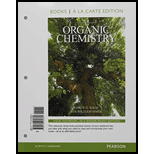
Organic Chemistry, Books a la Carte Edition (9th Edition)
9th Edition
ISBN: 9780134160382
Author: Leroy G. Wade, Jan W. Simek
Publisher: PEARSON
expand_more
expand_more
format_list_bulleted
Question
Chapter 14, Problem 14.53SP
Interpretation Introduction
Interpretation: The mechanism of the given reaction is to be identified.
Concept introduction: In acid catalysed reaction, the proton from an acid is transferred to the reactant.
To determine: The mechanism of the given reaction.
Expert Solution & Answer
Want to see the full answer?
Check out a sample textbook solution
Students have asked these similar questions
Br
Brz
CH3
CH3
H3C
CH2CI2
H3C
Br
Electrophilic addition of bromine, Br2; to alkenes yields a 1,2-dibromoalkane. The reaction proceeds through a cyclic intermediate known as a bromonium ion.
The reaction occurs in an anhydrous solvent such as CH,Cl).
In the second step of the reaction, bromide is the nucleophile and attacks at one of the carbons of the bromonium ion to yield the product. Due to steric clashes,
the bromide ion always attacks the carbon from the opposite face of the bromonium ion so that a product with anti stereochemistry is formed.
Draw curved arrows to show the movement of electrons in this step of the mechanism.
Arrow-pushing Instructions
Br:
:Br:
.CH3
H3C
H3C
CH3
Br:
The rate of bromination of the following three alkenes is very different: 2-methyl-1-pentene, 2-methyl-2-pentene, 3-methyl-1-pentene. Rank them in order from slowest to fastest to react.
A carbamate can be prepared by treating an isocyanate
with an alcohol, as shown here. This type of reaction is
used to synthesize polyurethanes- polymers that have
a wide variety of industrial applications, such as surface
sealants, high-performance adhesives, and synthetic
fibers. Propose a mechanism for this transformation.
R'—ОН
R.
`N=C=0
R.
OR'
An isocyanate
A carbamate
(Substituted urethane)
O=C
Chapter 14 Solutions
Organic Chemistry, Books a la Carte Edition (9th Edition)
Ch. 14.2C - Rank the given solvents in decreasing order of...Ch. 14.2D - Prob. 14.2PCh. 14.2D - In the presence of 18-crown-6, potassium...Ch. 14.3B - Give a common name (when possible) and a...Ch. 14.3C - Prob. 14.5PCh. 14.3C - Name the following heterocyclic ethers.Ch. 14.4 - Propose a fragmentation to account for each...Ch. 14.5 - Prob. 14.8PCh. 14.5 - Prob. 14.9PCh. 14.6 - Prob. 14.10P
Ch. 14.7 - Explain why bimolecular condensation is a poor...Ch. 14.7 - Prob. 14.12PCh. 14.7 - Prob. 14.13PCh. 14.8 - Prob. 14.14PCh. 14.8 - Prob. 14.15PCh. 14.8 - Prob. 14.16PCh. 14.10A - Prob. 14.17PCh. 14.10A - Prob. 14.18PCh. 14.10B - Prob. 14.19PCh. 14.11B - Show how you would accomplish the following...Ch. 14.11B - Prob. 14.21PCh. 14.12 - Prob. 14.22PCh. 14.12 - Prob. 14.23PCh. 14.12 - Prob. 14.24PCh. 14.13 - Prob. 14.25PCh. 14.13 - Prob. 14.26PCh. 14.14 - Prob. 14.27PCh. 14.15 - Give the expected products of the following...Ch. 14 - Write structural formulas for the following...Ch. 14 - Give common names for the following compounds. a....Ch. 14 - Give IUPAC names for the following compounds. a....Ch. 14 - Glycerol (propane-1,2,3-triol) is a viscous syrup...Ch. 14 - Prob. 14.33SPCh. 14 - Show how you would make the following ethers,...Ch. 14 - (A true story.) An inexperienced graduate student...Ch. 14 - Prob. 14.36SPCh. 14 - a. Show how you would synthesize the pure (R)...Ch. 14 - a. Predict the values of m/z and the structures of...Ch. 14 - The following reaction resembles the...Ch. 14 - Prob. 14.40SPCh. 14 - Prob. 14.41SPCh. 14 - Prob. 14.42SPCh. 14 - Give the structures of the intermediates...Ch. 14 - Prob. 14.44SPCh. 14 - Show how you would synthesize the following ethers...Ch. 14 - Prob. 14.46SPCh. 14 - Prob. 14.47SPCh. 14 - Prob. 14.48SPCh. 14 - An acid-catalyzed reaction was carried out using...Ch. 14 - Propylene oxide is a chiral molecule. Hydrolysis...Ch. 14 - Prob. 14.51SPCh. 14 - Prob. 14.52SPCh. 14 - Prob. 14.53SPCh. 14 - Prob. 14.54SPCh. 14 - In 2012, a group led by Professor Masayuki Satake...
Knowledge Booster
Similar questions
- In light of the fact that tertiary alkyl halides undergo spontaneous dissociation to yield a carbocation plus halide ion (see Problem 10-45), propose a mechanism for the following reaction.arrow_forwardNonconjugated , -unsaturated ketones, such as 3-cyclohexenone, are in an acid-catalyzed equilibrium with their conjugated , -unsaturated isomers. Propose a mechanism for this isomerization.arrow_forwardAldehydes and ketones react with thiols to yield thioacetals just as they react with alcohols to yield acetals. Predict the product of the following reaction, and propose a mechanism:arrow_forward
- Propose the detailed mechanism for the given reaction . Including the steps of initiation , propagation, termination.arrow_forwardGiven the information below, write out a reasonable mechanism for the reaction. Where not provided, also fill in the major product(s) of the reaction: Show all arrowsarrow_forwardSuggest a detailed mechanism for each of the reactions below. Explain why the originating products were formed.arrow_forward
- Come up with a detailed mechanism for the following cyclization that also includes all resonance strictures for any intermediates that form. Also, explain why the alkyl bromide portion of the molecule remains intact in the product even though the reaction conditions are strongly basic/nucleophilic. Br Br NaOMe Me Me Me Me MeOH MeO2C 0 °C MeO₂Carrow_forwardShow the reaction mechanism for the following multistep transformations. Show all reagents and the intermediate structures.arrow_forwardWhat's the mechanism and why?arrow_forward
- Provide the complete mechanism for the reaction below. You must include appropriate arrows,intermediates, and formal charges. Please draw out.arrow_forwardWhich mechanism class would this reaction be expected to undergo to form the major product? E2 E1 SN2 SN1 H CH3 OH H2SO4 CH3arrow_forwardGive a mechanism that accounts for the organic products of this reaction. Your mechanism must include a transition state that accounts for the stereochemistry of the product and/or reactant. Redraw the reagents as needed. CI OH NaOH, DMSO + NaClarrow_forward
arrow_back_ios
SEE MORE QUESTIONS
arrow_forward_ios
Recommended textbooks for you
 Organic ChemistryChemistryISBN:9781305580350Author:William H. Brown, Brent L. Iverson, Eric Anslyn, Christopher S. FootePublisher:Cengage Learning
Organic ChemistryChemistryISBN:9781305580350Author:William H. Brown, Brent L. Iverson, Eric Anslyn, Christopher S. FootePublisher:Cengage Learning

Organic Chemistry
Chemistry
ISBN:9781305580350
Author:William H. Brown, Brent L. Iverson, Eric Anslyn, Christopher S. Foote
Publisher:Cengage Learning
